Ah, prime rib roast… That perfect expression in beef! Huge slabs of tender beef, rosy red from center to edge, beneath a perfectly seared crust and charred fat cap with melt in mouth consistency and beefy flavors to die for. It’s a thing of beauty and a perfect meal often reserved for the holidays or very special occasions like birthdays or other major feasts.

Ladies and gentlemen, I give you prime rib roast in all her glory!
It’s a meal that I myself and my friends adore and one that usually knocks people off their feet when served properly. Sadly, though, prime rib roast is also one of those meals that entirely too many home cooks are downright scared of preparing! As if there were some big secret to perfect prime rib roast.
And what a shame, really, because nothing (save probably boiling water and a few other kitchen basics) could be easier than making prime rib roast at home – especially if you use my method below. Seriously! So, in the interest of public service, I – Johan – am here today to teach you how to cook prime rib perfectly – every damn time – in a few very simple steps! Most of which actually have to do with the sourcing of the meat!
I probably shouldn’t tell you this… Granted, I probably shouldn’t tell you how to do this as it’s going to make a lot of what I do seem a lot more simple and with this very post, my days of wowing at least a handful of ladies at every party I cater to are probably over… But friends don’t let friends be scared of simple tasks! So here we go my friends: your simple guide to impressing your friends with a task that looks horribly complicated, but is – in reality – dead simple!
With this post I intend to tell you every little secret (spoiler alert: there aren’t many!) to cooking a perfect prime rib roast, including how to get the perfect roast for the job, how to tackle the cooking process in four easy steps, and even how to make a nice red wine reduction sauce to go along. As always, if you know how to source a roast and don’t care about the background, you can jump straight to the recipe. If not, I hope you’ll read on and hopefully turn a little wiser on the subject of beef and prime rib. Before we get started, though, let’s answer the simple question on everybody’s mind: What’s so special about prime rib?
Oh, by the way? Looking for a sauce to go along? Why not try one of my personal favorites: Bearnaise, Demi-Glace or Bordelaise Red Wine Sauce.
Prime rib – the perfect cut of beef?
There are so many cuts of beef in this world. Some tender, some tough, some flavorful, some not. For my money, the best, most flavorful cut of beef in the world is prime rib. Granted, tenderloin is more tender, short loin (from whence strip steaks come) more pretty, belly cuts like flank and skirt perhaps more flavorful… But none beat prime rib in that perfect balance between tenderness and flavor… Or sheer animalistic beauty of presentation once roasted to perfection and plated up.
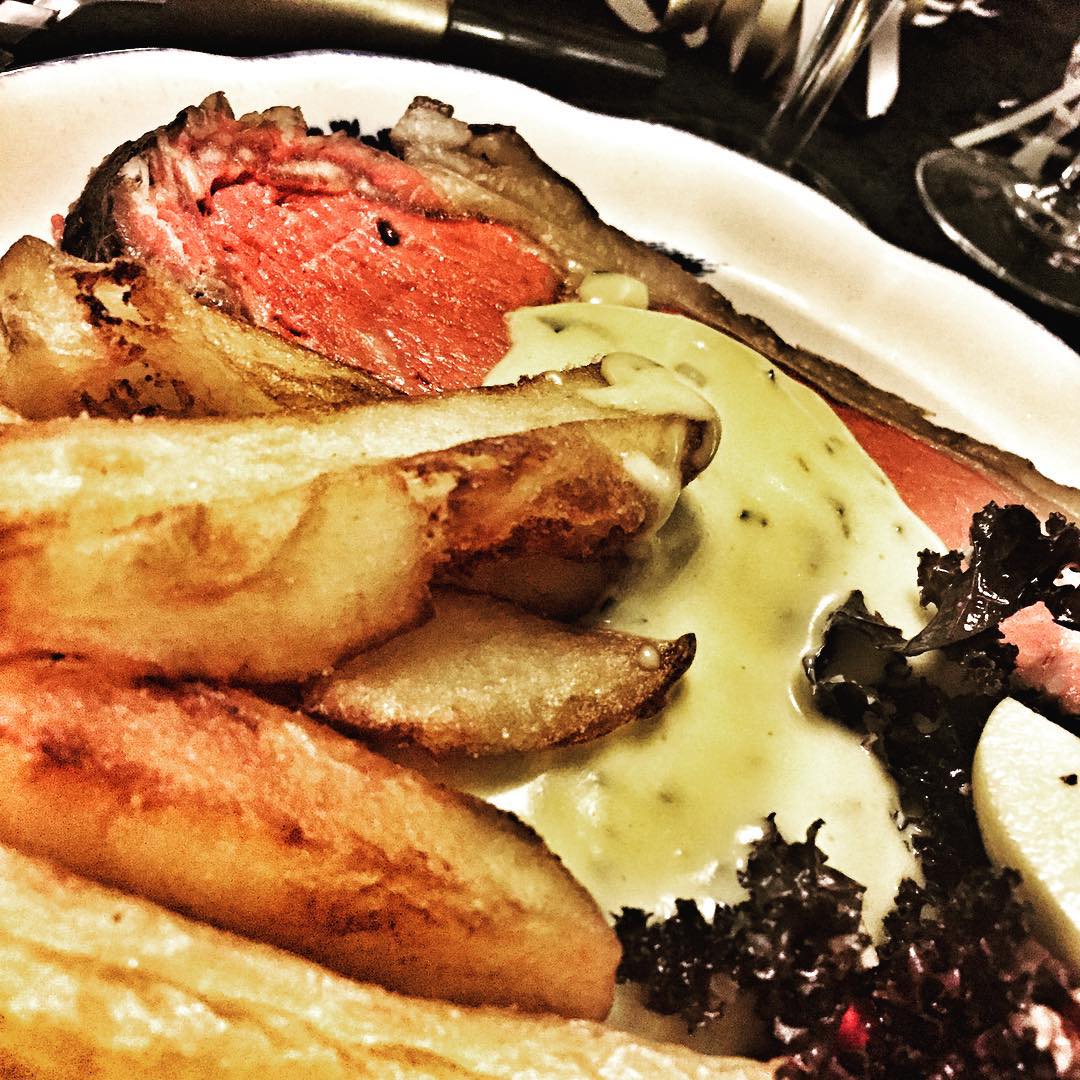
Prime Rib with home-cooked fries and Sauce Bearnaise. Life on earth is good!
Really? What about Beef Tenderloin, you say? That most sought after piece of meat on all the cow? Fuck beef tenderloin! (no, seriously, fuck beef tenderloin!) Tenderloin is perhaps the most tender cut of beef on all the animal, but really, that’s about all there is to it: a tender, buttery texture and end to no flavor. Beef tenderloin is so gosh-darn tender and expensive because it’s a relatively small piece of meat tucked away at the middle of the animal far from bones, joints, moving parts. Basically any part of the animal that does any bit of work. It is, in essence, a very relaxed piece of muscle that hasn’t done much work in its life time. Which makes it tender, but not flavorful, as muscles generally have to do some work to build up flavor. Beef tenderloin has tenderness, but what beef tenderloin lacks is exactly what makes other beef cuts tasty: inter-muscular fat, connective tissue and bone proximity. Prime rib, on the other hand, has all these things in just the right proportions. And that’s what makes prime rib just perfect! It does comparatively little work compared to other muscles which makes it tender even with very little cooking efforts involved. But it still has enough fat, connective tissue and bone proximity to render it extremely flavorful and rich.
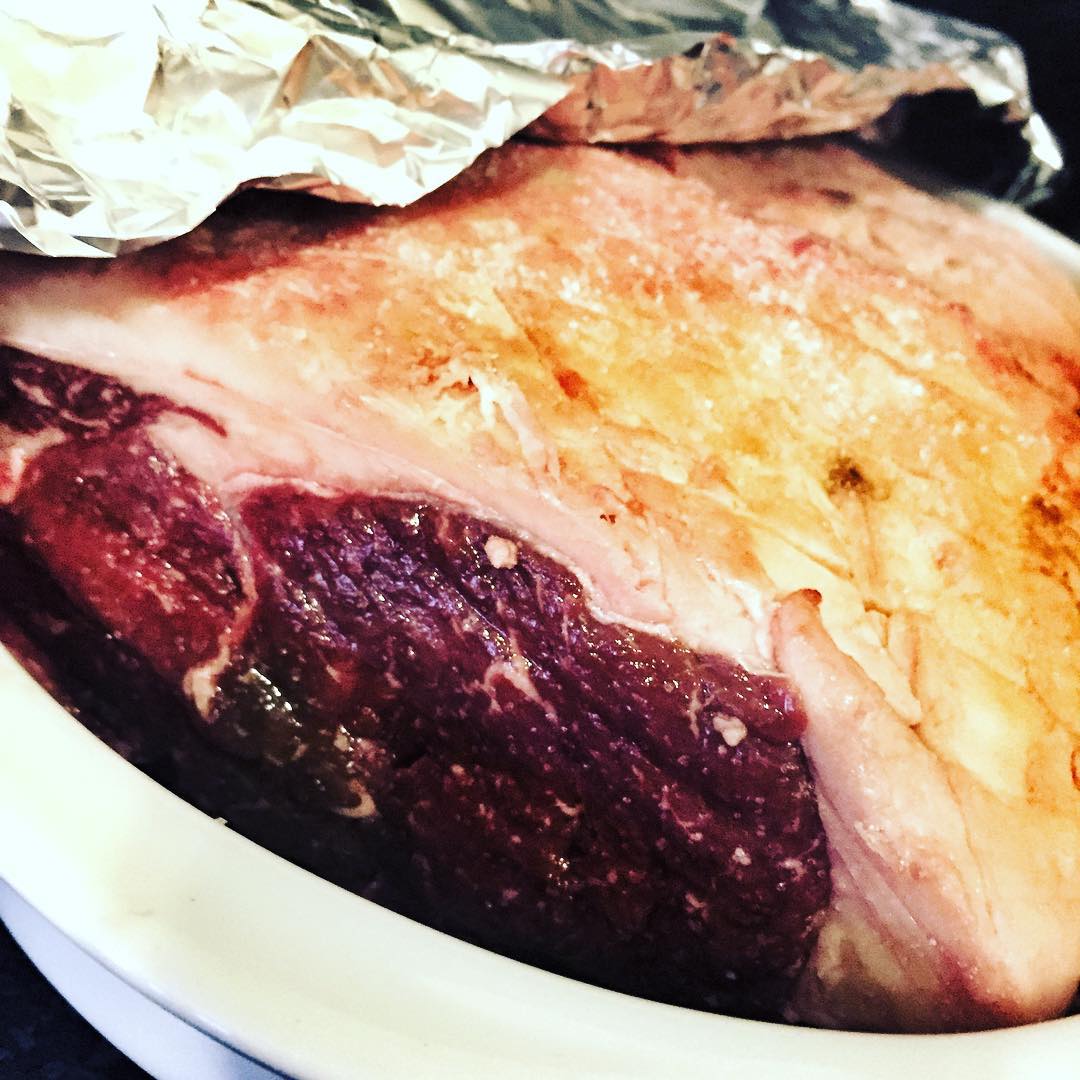
Well, hello darling!
It’s a bit more work to prepare cut and ingest, but at a lower price and five times the flavor of beef tenderloin, who cares? Not you? Good! Then let’s figure out how to procure and prepare said cut of beef! I promise you, it’s easier than you’d think. The hardest part, really, is finding the right piece of beef for the job. Luckily, though, we’ve got just the man for the job.
The perfect sides to go along…? Looking for the perfect sides for that perfect piece of roast? No worries, I have you covered. Look no further than my triple-cooked chips! Not in the mood for red wine sauce? Try my home-made Sauce Bearnaise!
For prime rib, you MUST talk to your butcher!
Let’s get this out of the way. Prime rib will never be cheap, nor will it be every day eats. It’s not a budget cut of meat and it should be kept for special occasions. So once that rare special occasion rolls around, let’s make the best of it. If we’re going to sacrifice a reasonable amount of money for meaty pleasures, we might as well sacrifice a few extra bucks and get the best possible piece of prime rib for those special occasions. And the only way we’re going to do that is by going out talking to the last of a dying breed: our friendly, neighborhood butcher!
So go see your butcher about prime rib and if, like some, this is your first time, you shouldn’t be afraid to put him to the test! A butcher should know his trade, source meat from a trusty source and treat said meat well until it lands in your hands. So go on, test him, ask him a bit about the source and the history of the reasonably expensive chunk of meat you’re about to buy. Then listen carefully to what he says and the confidence with which he says it: You’ll want to hear passion, confidence and pride in what he tells you. If not, step away and find another man for the job.

This is little miss 1240. We had some good rib from her. Don’t be upset if your butcher can’t trace your roast this far. But be not surprised if he can!
Don’t expect him to tell you the name and exact past whereabouts of the cow that went into your prime rib (yet, don’t be surprised if he knows!), but any good butcher should be able to tell you at least the breed, age and treatment of the beast that laid carcass to your carnivore needs – as well as the name and track record of the breeder. He should talk fondly of said breeder, said cow and show no uncertain amount of pride in the product he has on display. If not, we might as well go elsewhere! If, on the other hand, he passes the initial test, we can go on asking questions:
Ask your butcher for dry-aged prime rib!
If you’re a fan of roasts or steaks, you may well have heard of the term dry aging and you may well have wondered just what the hell it meant. Well… Dry aging, rather ironically, is a fancy new term for something that used to be the norm not too many generations ago. In order to properly develop tenderness and flavor, you see, beef needs to be aged. That is, essentially (like it or not), left to mature for anywhere from a couple of days to a couple of months, no, seriously! Maturing helps the fibers in the meat to break down and become tender all while intensifying the flavor of the meat as a nice side effect. Traditionally this was done by storing the cuts of meat in large, well-ventilated, temperature and moisture controlled (i.e. dry) compartments. A tedious and manual yet wonderful process, which, eventually, result in tender and perfectly flavorful beef.
This process, then known simply as aging, was the norm for decades until the Captains of Industry showed up and discovered that you could tenderize beef quicker and more cost-efficiently by wrapping it tightly in plastic, throwing it in the refrigerator and letting it “age” in its own juices… And since then this process, known as wet aging has sadly been the new norm of the supermarket industry and low grade butchers for a few very simple reasons: It’s fast, cheap, reliable and produces tender meat with very little loss and very few risks of spoiling.
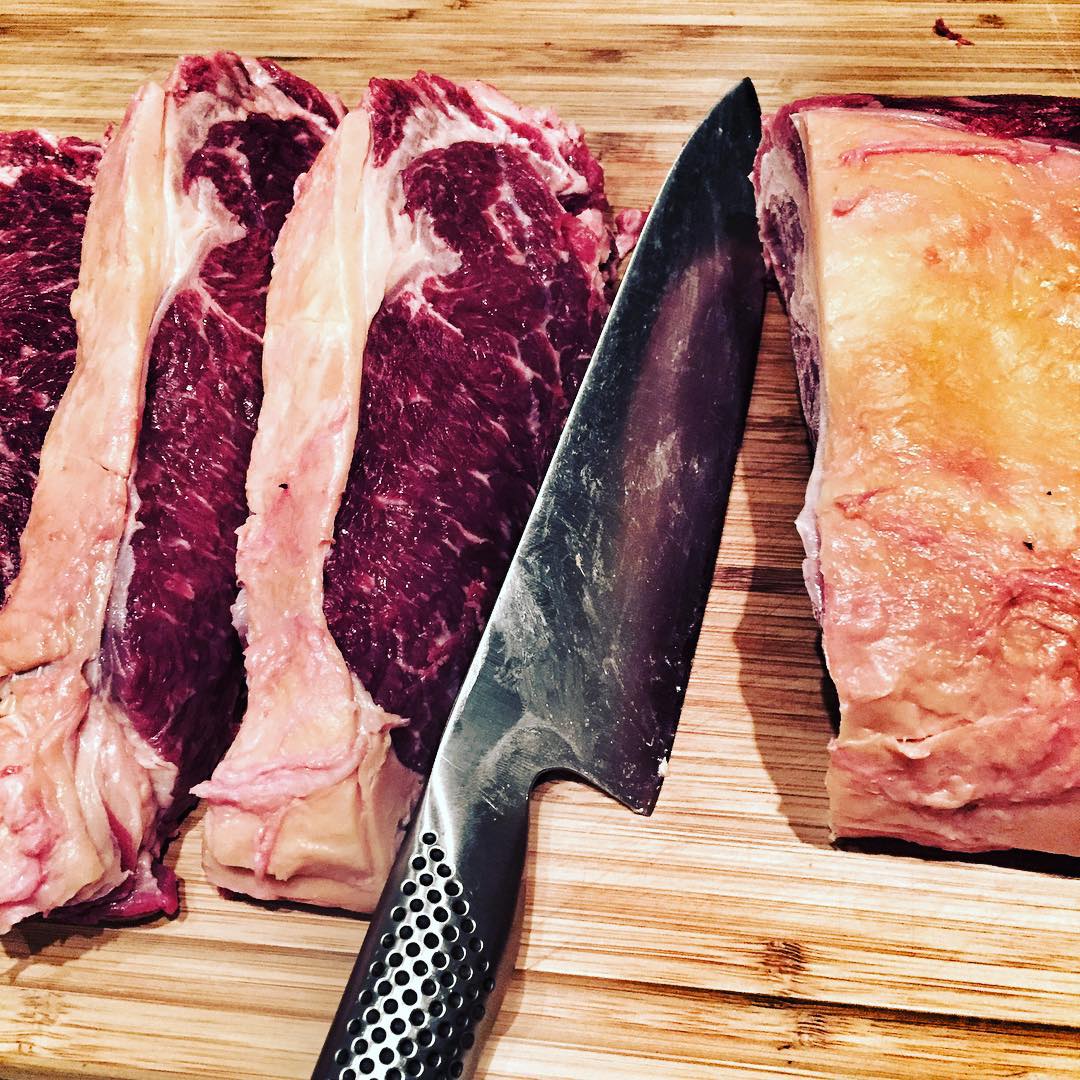
Free tip of the day! Want steaks? Buy an entire prime rib roast and cut them yourself. You save money and can have them however manly you like!
The traditional method, now known as dry aging, on the other hand, takes time, skill, monitoring and leads to loss of valuable beef real estate not only through loss in moisture during the process (water evaporates from inside the beef, increasing flavor), but also through careful trimming of the outer layer of meat as dry-aging, like it or not, is basically a form of controlled decay. The tenderness, flavors and aroma produced by the process, though, are second to none and worth every extra penny you drop for a properly dry-aged piece of beef: intense beefiness, nuttiness, a whiff of blue cheese (in the most enjoyable sort of ways), umami, muskiness, smoke… All of those perfect qualities that you only get with dry aging and that you never really knew you missed until you tried a piece of perfectly dry-aged beef.
Long story short, if we want the best, tenderest, most tasteful prime rib (and we do!), we should ask our butcher for dry aged beef and pay the extra buck for that extra meaty experience. Just this once. Believe me, you’ll thank me later!
Ask your butcher for bone-in prime rib if possible
Prime rib is called prime rib for a reason. Because it’s cut from the rib part of the animal. So, in reality, the roast actually sits on top of the rib bones of the cow. Many butchers, the supermarket variety especially, remove these bones for convenience and easy handling for the consumer. However, you can get so-called bone-in prime rib roasts where the bones are left in place. Like giant spareribs, basically. These are not always available, but you should be able to get them if you ask nicely. Especially if you order ahead. If you can, you really should consider getting meat on the bone. Why? Well, the reason is different than you may think.
The purpose of procuring and roasting the meat on the bones is not so much to add extra flavor as it is to add tenderness. The bone absorbs and reflects heat during cooking, causing the meat near the bone to heat up even slower and retain moisture, juiciness and tenderness during cooking. It’s pretty much as simple as that. Bone, in this case, does not add much flavor. It merely makes for an even more tender and juicy roast. Which is just what we want. At pretty much no extra labour, I might add!
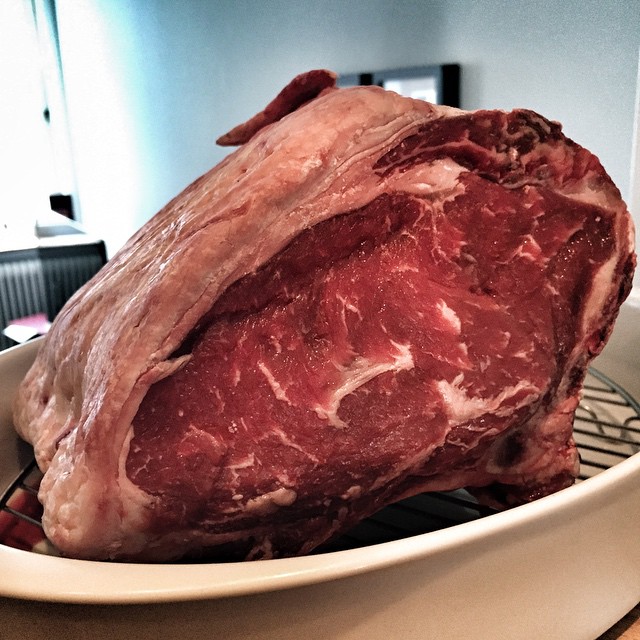
Prime rib on the bone, with beautiful marbling. It’s a sight to behold
“Really?” You ask. “No extra labor?” – “Yes,” I answer! – “But what of removing the bone after cooking,” you ask? Worried about having to remove the bone after roasting? Don’t be! It’s actually a pretty simple procedure if only you get a really sharp, thin and preferably flexible knife, then follow these simple carving guidelines after roasting. Still worried? Ask your butcher to lend you a helping hand. He’ll be more than happy to trim the bones off the roast and tie them back on for easier removal after cooking.
Can’t get bone-in prime rib? Well, no worries, the procedure we’re about to go through works just as well on a boneless piece of prime rib. Do not let bones be a deal breaker, but do consider bone-in, if you have the choice!
Ask your butcher to show you… the beef!
So far, so good, we’ve made a few informed and very deliberate decisions about our prime rib roast, we’ve gotten to trust our butcher, now comes the important part: striking the deal! But before you do, ask him to show you the goods, like really show you the goods. He shouldn’t be afraid to pick up the meat and spin it around for your greedy eyes to behold. As he does, here are a few things to look for.
The meat should be dry and not swimming in a wad of its down juices, this is a sign of proper (dry) aging. It should, however still be slightly mushy in appearance, not tough and leathery. It should be a deep, dark red but not going on brown or black. It should contain a nice fat cap at the top and there should be fat fibers running through the meat. This is called marbling and it’s not a sign of poor inexpensive beef. Rather, it’s the sign of a well-fed cow that has had a good, long life and eaten well. The marbling is what gives prime rib it’s intense, unique flavor and tenderness! The fat, by the way, can vary in color from clear white to yellowish. Yellow fat is not a sign of an unhealthy animal, far from it. Rather it’s a sign of a healthy diet. Yellow fat is a sign of grass feeding and grass-fed beef is generally more flavorful, well-treated and slow-raised than the industry standard grain-fed animals. Entire articles could be written on the differences between grass and grain-fed animals. In fact entire articles HAVE been written on the subject, so I’ll leave it at telling you to consider yellow fat a positive sign. If you want to know the details, check out this amazing read amongst others.
Like what you see? I thought so! Now, stake the deal, bag that sucker up and let’s get home and get cooking!
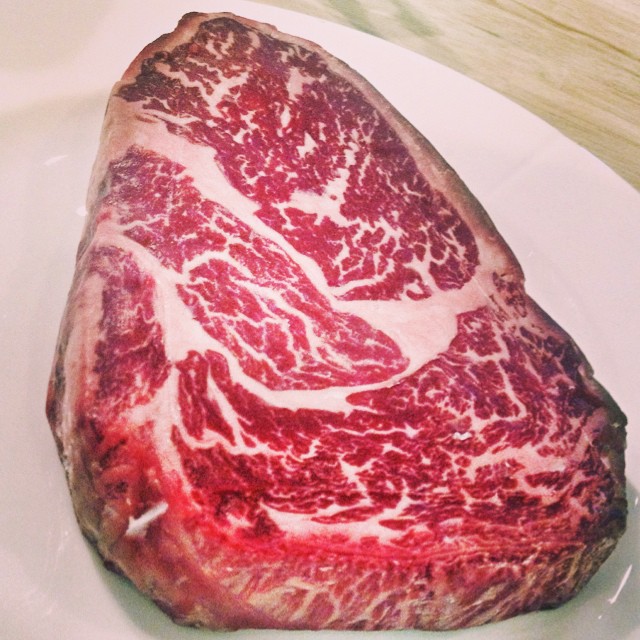
Intermuscular fat is not a sign of bad or cheap meats. This is Wagyu, one of the world’s most expensive breeds, it’s fatty, buttery and absolutely fantastic! (Discolorations, by the way, are due to lighting and poor camera equipment, not poor beef)
Cooking Prime rib roast – the fool-proof way!
So, we’ve procured a very expensive piece of meat, we’ve done our research, taken every precaution and given things a lot of thought. Now, then, how do we cook up our prime rib without ruining it? Well, in the case of my recipe below, we start by giving it a soak in a marinade… This step, I should mention, is completely optional and merely serves to add a bit more flavor and give us an easy sauce base to start with. You can follow this step or skip it, it’s not essential to the technique. What is essential, though, is one, very important little factor: time!
Want to know the single secret trick to cooking prime rib perfectly every damn time? Patience! In the immortal words of Axl Rose: all we need is just a bit of patience.
A perfectly cooked prime rib roast has three main characteristics: a nice sear on the outside and an incredibly tender and beautifully pink interior that stretches as far from the center towards the edge of the meat as at all possible. And here’s the thing. Many home cooks are under the misconception that this level of perfect doneness, this stage of beef nirvana is somehow hard to achieve. Hard to achieve? I think not. You see, as long as we have properly sourced our meat, two things and two things only can ruin a proper prime rib roast. Cooking it too hot and fast or overcooking it. Cooking too quickly leads to a less tender beef experience, overcooking – on the other hand – leads to dry, grainy and less flavorful beef.
If we can eliminate those two risks, we can have perfectly cooked prime rib every damn time! And we can get rid of both risks in one very simple step: By giving the finger to all established tricks and recipes and create our own recipe in which we lower the heat throughout the entire cooking process. Like, really lower our heat! I’m talking 65 degrees Celsius (150 Fahrenheit) worth of low heat here!
Why 65 degrees? Well, people like their meat at different degrees of doneness, but in my opinion anything served above 65 degrees is a total loss. 56 would be a lot better for me while most people hit their sweet spot between 58 and 62 degrees. But, if we set our oven to 65 degrees, it doesn’t take a rocket surgeon to figure out that things can’t go horribly wrong! Things will take some time, granted, but they can’t exactly go wrong! And what role does time play, really, when we’re talking basically unattended cooking time during which we can do other things, like getting our shopping done, preparing some sides, drinking a hell of a lot of wine, or… Ahem, the choices are endless, really!
Basically, with this approach, you can pop the roast in the oven early in the afternoon, jack a probe thermometer with a temperature alarm setting at around 58C in it as a precaution, then forget about it for the rest of the day until dinner time where you’ll have perfectly roasted, perfectly juicy, tender and flavorful prime rib. How awesome is that?!
Searing creates flavor: what of the crust?
Starting a roast and forgetting about it? Sounds almost too good to be true, right. Well, it isn’t! Sort of! Our low and slow roasting method leaves really only one small problem… Crust! Any chef worth his salt will tell you that a good crust is essential to any piece of red meat, be it a roast, a steak, or even diced or ground meat for stews. You probably know this, too and adhere to the rule. But do you know why? Well, a quick sear over scorching high heat caramelizes the outside of the meat, creating new, deep, meaty flavors through a beautiful little thing called the Maillard reaction, and this particular reaction is something we really can’t replicate in any other way – nor do without if we want perfectly tasty results.
The Maillard reaction: The Maillard reaction, named after its discoverer, Louis Carmine-Maillard, is a chemical reaction between amino acids and reducing sugars caused by high heat that give browned foods its desirable flavors. For a more thoroughly geeky write-up, see this Wikipedia entry.
That leaves us with a problem, though. I’m suggesting we cook our roast at a low, steady 65 degrees which, however much we try, just isn’t going to produce any browning at all… So what do we do? Well, we’re going to do what most people in our shoes would do, which is to first brown the meat as quickly as we can using a blast over very high heat, then finish cooking it slowly. Where most recipes call for doing this by inserting the meat into a very hot oven and then immediately turning the temperature down and cook till done, we’re going to do things a little differently here in Johan-land.
What I suggest rather than the old school approach is a new approach in which we we:
a) Brown the meat quickly over very hight heat. If your roast is ten pounds or less, I actually suggest doing this on the stovetop in a large cast iron pan. Otherwise a very hot oven will do the trick just nicely.
*b) Remove the meat from the heat and let it rest for about 20 minutes while the oven comes up (or down) to temp.
c) cook the prime rib low and slow to perfect doneness in a 65C oven.
d) let the roast rest covered for about 20-30 minutes before carving and serving.
Imposing a short resting period between browning and cooking may seem like a very subtle change, but it actually works wonders in helping us achieve our goals of a perfectly juicy and pink prime rib roast. Not only does it allow the surface of the meat to come back down in temperature after the heavy onslaught of heat, which in roast terms translates into a larger pink core and less risk of ugly, chewy grey spots around the edges of the roast, it also allows the fibers of the meat to relax and recover from the thermal shock, making for a more tender and juicy final product. And for that I’m willing to sacrifice an extra step and an extra 20 minutes any day of the week. The devil is in the detail, friends!
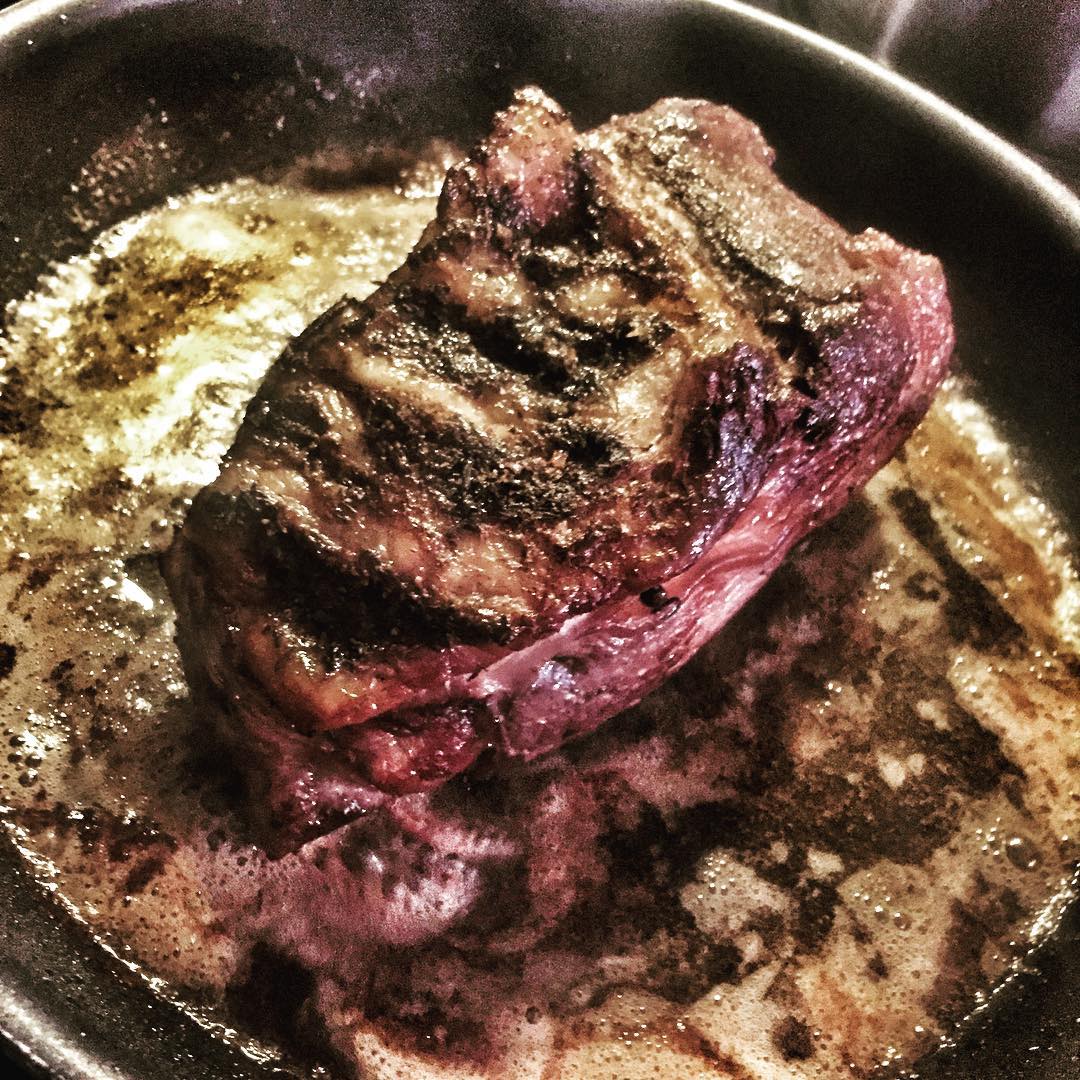
Browning a smaller prime rib roast? A hot pan is your best tool for the job!
As for the slow roasting, I think we’ve been through the ups and downs, advantages and what not of this step already. Which leaves only the final resting period which is as important here as in any other beef recipe. You see, subjecting raw meat to heat (however low or high) agitates the fibers of the meat, causing them to contract, effectively. This pushes the juices in the meat – the juices we have fought so hard to keep in there with this lengthy roasting job – out of the fibers and towards the center of the roast. If we were to just cut into the meat immediately after roasting, those juices would pour right out onto the cutting board. If, on the other hand, we allow the meat to rest for, say, 20-30 minutes, the muscle fibers relax and the juices redistribute evenly through the fibers of the meat. And will remain there even as we cut into the roast, making for more juicy, more flavorful and tender beefy bites come dinner time! And that, friends, is why resting your meat before cutting is important. That goes for steak, too, by the way.
Resting steak, not roast? If you’re cooking steak rather than a roast. You obviously should not rest your meat for nearly as long as the whole process will be lot faster here. A general rule of thumb when cooking steak is that it should rest for the same amount of time as it has roasted.
Oh, and here’s a little added bonus to our low and slow approach. You see, however, important resting is, with resting comes a bit of a problem in most traditional roasting recipes. A problem which has ruined many a roast for many a home cook. A problem known as carry-over heat!
Resting the roast: No carry-over, no problem!
One phenomena that many home cooks have fallen prey to is one know as carry-over heat. Carry-over heat is basically a term for excess heat that is absorbed in large cuts of meat during cooking. Once removed from the heat source, in this case the oven, the carry-over heat continues to “cook” the meat during the resting period, causing the internal temperature to rise anywhere from 2 to 5 degrees celcius above the temperature at which it was removed from the oven… This fluctuation, granted, does not sound like too big of a deal. But keeping in mind that the difference between rare and medium is about 5 degrees, you can probably easily see why not factoring in carry-over heat can have absolutely catastrophic consequences for a piece of perfectly cooked red meat.
The way of dealing with carry-over heat is usually to pull the roast from the oven a few degrees before it reaches the desired doneness, an effective yet somewhat unpredictable approach. Luckily, with our new roasting technique, we need not even give carry-over heat a second thought. With our low and slow procedure, we effectively eliminate much of the “problem” of carry-over heat. As we are cooking our roast at such a gosh-darn low temperature, there isn’t much excess heat to worry about. You can pretty much simply pull the roast at the desired temperature and rest it losely covered in tin foil for a good half hour without worrying about it cooking further or drying out. Then slice to order to feed your hungry and extremely grateful guests the best, tenderest and most juicy and flavorful prime rib, they’ve ever had.
Right, that’s not to difficult is it? Wait, it all sounds a little complicated put into so many words? It’s really not. Here, let me put it into a short and easy to follow recipe for you. I’ve even included a recipe for a red wine marinade and an easy yet flavorful sauce you can cook whilst waiting for the beef to finish in the oven. Want to make this even easier and quicker? You can skip the marinade and sauce making step and instead just serve it up with whichever sauce or non-sauce you desire. Compound butter anyone?
Prime Rib Roast Recipe: The Fool-proof way
Alright, here we are, then. Our fool-proof method in details. But first, one very important question that I have not yet answered. How much beef should you buy per person? Well, opinions vary wildly. From around 200 gram per person to 500 grams per person. Depending on who you ask. I find that if you go with 300 grams per person, male or female. You will have MORE than enough. So that’s what I went with here.

Easy Fool-proof Marinated Prime Rib Roast Recipe
Ingredients
- 3 kilo bone-in prime rib roast
Marinade:
- 500 ml red wine I prefer a nice Rhone blend
- 2 shallots peeled, roughly diced
- 4 garlic cloves mashed with the blade of a heavy knife
- 15 sprigs of thyme
- 1 bay leaf lightly crumbled
- 10 black pepper corns lightly cracked
- 1 tablespoon Worcestershire Sauce
- 1/2 tablespoon soy sauce
Sauce:
- 100 grams bacon preferably dry-cured
- 1 liter quality beef stock
- 1 shallot finely diced
- Salt and pepper to taste
Instructions
Marinate roast:
-
Combine all ingredients for the marinade in a large bowl and stir to combine.
-
Place prime rib in a large plastic or zip-loc bag, carefully add the marinade and squeeze out as much air as possible, then seal tightly.
-
Put the prime rib, bag and all, on a tray and stash in the fridge.
-
Allow prime rib to marinade for 24 hours in the fridge, turning it over a couple of times.
Searing the roast:
-
Carefully cut open the plastic bag and pour excess marinade into a bowl, you’ll need this for the sauce.
-
Free the roast of any stray bits of thyme, pepper, shallot, garlic and what have you, add these pieces to the reserved marinade.
-
Pat the roast dry using paper towel, sprinkle generously with coarse salt and allow to rest at room temperature for a few hours.
-
Heat a cast iron pan on high heat for at least a couple of minutes.
-
Once pan is smoking hot, add a tablespoon of high smoke-point oil, then an equal amount of butter.
-
Once butter is melted, brown roast briefly but thoroughly on all sides, turn off the pan and set the roast aside to rest for 20-30 minutes.
-
While roast is resting, preheat your oven to 65C.
Roasting:
-
Plunge a thermometer into the center of the roast, then place the roast in a tray in the middle of the oven.
-
Cook roast low and slow for hours and hours (expect this to somewhere around 6-8 hours, possibly more) until thermometer reads 56C (rare), 58C(medium rare) or 62C (medium).
Making the sauce
-
While roast is cooking, fetch out a medium sized sauce pan and put it over medium heat, add a tablespoon of butter and wait for it to melt.
-
Add bacon and shallots and allow to cook for a few minutes until browned and very fragrant.
-
Add reserved marinade, turn heat to high and bring to a light boil.
-
Once a boil has been reached, back the heat down to medium and cook until liquid has reduced by about two thirds.
-
Next, add your stock, bring the heat back up and cook until reduced by half and slightly thickened.
-
Strain out shallots, bacon bits, thyme and what have you, making sure to squeeze every bit of liquid out of the strained bits. Set sauce aside till needed.
Finishing up:
-
Evacuate roast from the oven or turn down the heat below 55C until ready to eat.
-
Remove roast from oven and leave to rest lightly covered for 20-30 minutes.
-
While the roast is resting, heat the sauce back up to a near boil. If it seems too thin, you can add a bit of corn starch slurry or other thickener.
-
Once sauce is hot and roast is rested, slice the roast into generously thick slices and start plating them up. Add any drippings from the roast along with the liquid that may have seeped out during cutting to the sauce and stir for a few seconds before saucing the meat.
-
Serve to a large crowd of hungry, happy friends.
Prime rib roast: So? What have we learned today?
We’ve learned that cooking one of the most precious holiday dinners and special occasion meals known to man is about as easy as to turn on the oven and wait for about a day.
We’ve learned that the real secret to perfect prime rib lies not so much in the cooking but in the sourcing of the right piece of meat for the job.
We’ve learned that to get the right piece of meat for the job, we need to talk to our local butcher and we’ve even learned which things to ask him and what to look for in the piece of beef that he recommends.
Basically, we’ve learned that prime rib does not have to be scary to prepare if only we’re willing to sacrifice a bit of money, time and thought to the cause. Indeed, my friends, impressing people can be easier than you think. Now, go out into the world and wow those friends of yours. Good luck!
Oh that looks stunning!
Aww, hey thanks! Thanks for dropping by and taking the time to comment, I really appreciate that. I do love me some good prime rib 🙂
It was worth commenting on! 🙂
Tonights the night for a maybe start or get up real early and start for a long low and slow bake. Your way is less expensive than an Alto-Schamm.
I’m planning on trying this tomorrow and I’m so excited about it. I’m sure my family’s going to like this as well. Thanks a lot for posting!
You’re very welcome. I hope everything went well 🙂